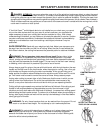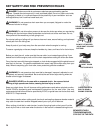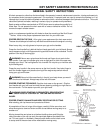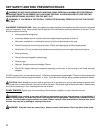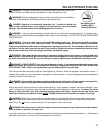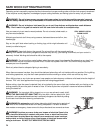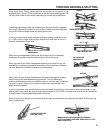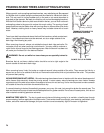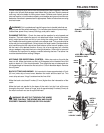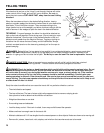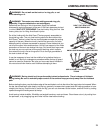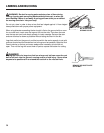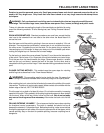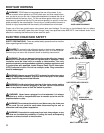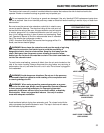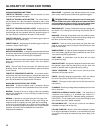
27
Please note that felling a tree is more complicated than often expected. Take time
to plan cuts, fall path and escape route before felling the tree. Electric powered
units may not be suitable for felling some trees. Consider such factors as tree
size and location, circuit breaker capacity, and weather and ground conditions to
determine if an electric powered saw is appropriate. Refer to instructions on using
an electric saw.
WARNING! Call a professional tree-felling service to handle jobs that are
beyond your abilities and knowledge. This includes trees that are precariously
located near power lines, homes, buildings, and public roads.
PLANNING THE FALL - Check the tree and the weather for wind speed and
direction. The trunk should be sound, not rotted and hollow. Look for branches,
which might become free and fall on you during the cutting work. Wear a hard
hat. Prepare the working area and clear your escape route. This route should be
to the rear, but not straight back. Going more to the side is safer. Decide whether
wind conditions plus the natural lean and balance of the tree will enable you to
fell the tree in the desired direction. At any risk of a wrong-way fall, consider
using a wedge to help start the tree in the right direction. If the trunk is too small
in diameter for insertion of a wedge, consider tethering the tree. The tether line
must be attached before cutting is begun.
NOTCHING FOR DIRECTIONAL CONTROL - Make two cuts on the side the
tree is to fall. Make the bottom cut first, at 90 degrees to the intended line of fall
and to a depth of 1/3 the trunk diameter. Then angle the top cut downward at a
45-degree angle to intersect the first cut at the 1/3 trunk diameter depth. Remove
the cut piece.
BACK CUTTING AND HINGING - It is important to leave approximately a 2 inch
(50 mm) wide strip of wood uncut between the notch and the back cut. This
uncut strip acts as a “hinge” to determine the line of fall.
Make the back cut at least 2 inches (51 mm) higher than the intersection of the
notch.
Make the back cut parallel to the base of the notch, but don’t cut all the way
through to the notch. Leave a “hinge” strip of approximately 2 inches (51mm) so
the notch and back cut are of equal thickness.
WARNING! DO NOT CUT THROUGH THE HINGE!
THE TREE CAN FALL THE WRONG WAY AND CAUSE
PROPERTY DAMAGE, SERIOUS OR FATAL INJURY.
ALL
SURVEY TREES BEFORE
FELLING
KEEP BODY AWAY FROM
KICKBACK PATH
SIDE VIEW
UNCUT
HINGE
2"
1
ST
CUT
BACK
CUT
NOTCH
DEPTH
1/3 OF TRUNK
DIAMETER
NOTCH
CUTS
FIRST
USE
WEDGES
IF ROOMF
BACK CUT
LAST
90°
LEAVE 2" HINGE
FALL
2
ND
CUT
2"
FELLING TREES



